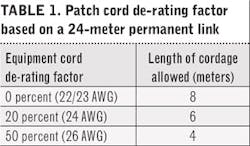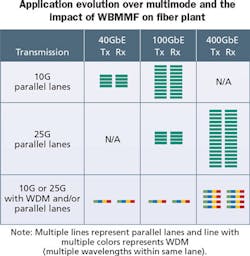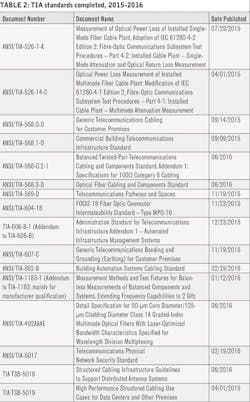By Cindy Montstream, RCDD/NTS, EE, CPLP, Legrand North America
Two high-profile standards were just completed at the Telecommunications Industry Association (TIA) TR-42 Engineering plenary meeting: Specifications for 100Ω Category 8 cabling (ANSI/TIA-568-C.2-1 Addendum 1) and the specification for Wideband Multimode Fiber (ANSI/TIA-492AAAE).
The TIA TR-42 Engineering Committee (the telecommunications cabling systems committee) recently had the second of three annual plenary meetings in early June. It is at these meetings that new projects are started, ballot comment resolution takes place and correspondence to and from other standards organizations (e.g. IEEE, ISO/IEC) and industry organizations (e.g. BICSI) occurs.
Some of the standards that the TR-42 subcommittees develop and update are for cabling and component specifications to support new IEEE application requirements. One such example of this is the completion and approval for publication of the Category 8 standard. The original catalyst for this cabling specification was the development of the 40GBase-T standard in IEEE that required a twisted-pair specification with better electrical performance, over a larger frequency range, than Category 6A and the ISO component Category 7 and Category 7A specifications.
This article will provide a general overview of the standards work that is ongoing, some work that was just completed, and new projects that have been started. A list of recently published standards is provided at the end.
ANSI/TIA-568-C.2 Addendum 1 (Category 8)- After three years of work, the specification for four-pair, balanced twisted-pair copper cabling that can support 40 GbE up to at least 30 meters in a two-connector channel has been completed. This work was initiated in 2013 as a result of IEEE forming that task group IEEE 802.3bq to develop 40GBase-T, 40 GbE (40 Gigabit Ethernet) over cost-effective twisted-pair cabling.
Some of the main objectives of the task group, relating specifically to the physical layer were:
- Support local area networks using point-to-point links over structured cabling topologies, including directly connected link segments;
- Support a data rate of 40 Gbits/sec;
- Define a link segment based upon copper media specified by ISO/IEC JTC1/SC25/WG3 and TIA TR-42.7 meeting the following characteristics-4-pair balanced twisted-pair copper cabling, up to two connectors, up to at least 30 meters
The Category 8 channel is a two-connector model, using foiled twisted-pair (FTP) cable with a maximum permanent link length of 24 meters (79 feet). Category 8 transmission performance is specified from 1 MHz to 2000 MHz.
Horizontal and backbone cable will consist of four balanced twisted pairs with conductors that can range from 22 AWG to 24 AWG. Cord cable consists of four balanced twisted pairs with conductors that range from 22 AWG to 26 AWG. Although there is no restriction on the use of unshielded twisted-pair cable in the standard, performance has not been achieved with unshielded twisted pair. Category 8 is a shielded solution with no specifications for bundled or hybrid cables.
Category 8 employs the RJ-45, an eight-position modular jack common to Base-T applications and supported over structured cabling systems, defined within TIA. It also supports autonegotiation for backward-compatibility because it still uses four-pair balanced twisted-pair cable used by other cable categories.
The length of the channel can vary from 28 meters to 32 meters, depending on the length of cordage (patch/equipment cords) allowed. This is because the patch cord length allowed is dependent on a de-rating factor. The de-rating factor is based on the wire gauge size (AWG) of the conductor used in the cordage.
Although this is a great departure from the traditional 100-meter (328-foot), four-connector channel, Category 8 is backward-compatible with existing cabling and equipment to allow autonegotiation between 100 Mbits/sec, 1 Gbit/sec, 10 Gbits/sec and 40 Gbits/sec over balanced twisted-pair cabling. The Category 8 specification is published as Addendum 1 to TIA-568-C.2 (ANSI/TIA-568-C.2-1).
ANSI/TIA-492AAAE (Wideband Multimode Fiber) - The TR-42.12 Subcommittee approved the Wideband Multimode Fiber (WBMMF) standard for publication. The standard specifies high-bandwidth 50-μm core diameter/125-μm cladding diameter, laser-optimized optical fiber that is optimized for enhanced performance for single-wavelength or multi-wavelength transmission systems with wavelengths in the vicinity of 850nm to 950nm. The actual operational band is from 850nm to 953nm. The effective modal bandwidth (EMB) for this new fiber is specified at the lower and upper wavelengths: 4700 MHz·km at 850 nm and 2470 MHz·km at 953 nm. There is no OMx designation yet. The OMx designation comes from ISO/IEC. There are several options being debated currently including Om4w, Om5, Om5w.
This is a significant standard for multimode fiber because it makes wavelength division multiplexing (WDM) possible over multimode fiber. Because the fiber is optimized for short wavelengths, the WDM used over multimode fiber is commonly called short wavelength division multiplexing (SWDM). Up until now, WDM has only been used with singlemode fiber. WDM is important because it is one of four ways to increase the data rate: WDM, parallel transmission with multiple fibers, increased modulation and using multi-level coding.
The figure on the previous page shows how this new standard can influence fiber plant for current and in-progress Ethernet standards. The current 40-GbE (40GBase-SR4) standard, using short wavelength over multimode fiber (MMF), uses a lane rate of 10 Gbits/sec with eight fibers; four fibers for transmission and four fibers for receiving. Using WBMMF that supports four wavelengths (in effect four lanes) the four transmit fibers is reduced to one fiber as are the receive fibers. The fiber cable plant is reduced from eight fibers to two. 100 GbE is an even better example because the original standard released in 2010 (100GBase-SR10) required a total of 20 fibers, 10 transmit and 10 receive, using a 10-Gbit/sec lane rate. A new 100-GbE standard (100GBase-SR4) was published in 2015 specifying a 25-Gbit/sec lane rate, which allowed the fiber count to be reduced to a total of eight fibers; the same fiber count as 40 GbE. This is an example of how increased modulation reduces fiber count. Using SWDM with the new WBMMF will reduce the fiber plant to two fibers for 100 GbE, using a 25-Gbit/sec line rate. Both 40 GbE and 100 GbE are reduced to duplex transmission.
The 400 GbE is a current project within the IEEE 802.3bw working group. Phase I of this standard specifying transmission over multimode uses parallel transmission with a lane rate of 25 Gbits/sec. This will require a total of 32 fibers. Employing SWDM over WBMMF reduces the fiber count to 8 fibers, 25 percent the number of fibers required in Phase I.
ANSI/TIA-568.3-D (Fiber Cabling and Components) - The D revision of the ANSI/TIA-568.3 was just completed and approved for publication by the TIA TR-42.11 Subcommittee. One of the most significant changes with this standard is that it has transitioned from a component standard in the C revision to a cabling and component standard in the D revision. Through the C revision, the primary information in the 568.3 standard was for specifications and testing for fiber components. This information was important to reference for component compliance in project specifications but used mainly by manufacturers.
The new D revision has incorporated information from 568.0 to make it a cabling and component standard. This is why the original name “Optical Fiber Cabling Components Standard” has changed to “Optical Fiber Cabling and Components Standard.” Some of the information incorporated includes optical fiber polarity content and optical fiber test measurement requirements from ANSI/TIA-568.0. Passive optical network component specifications have also been included.
To make the standard more relevant to what is being installed, polarity of cords and connectivity methods supporting parallel optical signals for transceiver interfaces, along with array connector (MPO) patch cords and cables that exclusively employ two rows of fibers per plug have been included. However, it allows array connectivity (MPO) of arbitrary row width following patterns of the illustrated 12-fiber row components. It also adds the specification for wideband multimode fiber.
Other noteworthy changes include no longer recommending the use of Om1, Om2 and OS1. The maximum allowable Om3 and Om4 attenuation at 850 nm has been lowered to 3.0 dB/km from 3.5 dB/km.
The minimum return loss of singlemode connections and splices has been changed from 26 dB to 35 dB to harmonize with IEEE. This is going to make being able to field-polish singlemode connectors and still meet the required minimum return loss for the singlemode connection very difficult.
Finally, this revision specifies encircled flux launch conditions for testing multimode connector performance at 850 nm but eliminates the requirements for testing multimode connector performance at 1300 nm.
ANSI/TIA-568.2-D draft (Copper Cabling and Components) - Work on the D revision of the 568.2 standard for copper cabling and components has begun in the TIA TR-42.7 now that the work on the Category 8 standard has completed. This standard will also transition from a component-only standard to a cabling and components standard like the 568.3-D revision did. This work has just started so it is too early to provide an overview of the specific changes; however, the standard will include all addenda including the Category 8 specification in Addendum 1.
TIA-942-B draft (Data Center Standard) - Work on the B revision of the 942 Data Center Standard has begun. As part of the five-year maintenance process, the document went through its first ballot process earlier this year and comment resolution was completed during the last plenary meeting in June. As with any new revision of a standard, all addenda from the previous revision are incorporated. Therefore, Addendum 1 from the A revision, which addresses data center fabrics, has been incorporated.
There have been new cabling and connector standards since the A revision was published in 2012. The 16- and 32-fiber MPO-style array connectors have been added as additional connector types for termination of more than two fibers. The 16- and 32-fiber connectors were recently standardized when ANSI/TIA-604-18 (FOCUS 18) was published to support the Phase I specification for transmission of 400 GbE over multimode fiber. It also adds Category 8 as an allowed type of balanced twisted-pair cable, and changes the recommendation of Category 6A balanced twisted-pair cable to Category 6A or higher. It is expected that WBMMF will be included, also. The WBMMF standard hadn’t been approved for publication during the last ballot.
The comment resolution was not completed at the June meeting so there will be two interim meetings to complete it. Changes based on the comment resolution will be incorporated and this standard will go out for another ballot so that the next round of comment resolution can take place at the meeting in October.
TIA-1179-A draft (Healthcare) - Comment resolution was completed on the TIA-1179-A Healthcare Standard. References were updated to account for new revisions of other referenced standards.
Significant changes from the previous edition include the following.
- Balanced twisted-pair backbone cabling is now Category 6A minimum
- Balanced twisted-pair horizontal cabling is now Category 6A minimum
- Om4 is the recommended minimum for multimode optical fiber cabling
- A minimum of two fibers are now required for optical fiber backbone cabling
- Array connectors are now permitted for optical fiber cabling in the work area
- MUTOA and consolidation points may be used as additional network elements
- Requirements were added for: telecommunications pathways and spaces (additional requirements to those in ANSI/TIA-569-D); bonding and grounding; firestopping; broadband coaxial cabling; multi-tenant building spaces
- Recommendations were added for cabling for wireless access points and distributed antenna systems
The draft will go out for another industry ballot.
TSB-5018 (Distributed Antenna Systems) - TSB-5018 (Telecommunications Systems Bulletin) on Distributed Antenna Systems, was approved for publication. This TSB provides guidelines for DAS cabling infrastructure including cabling topology, design, components, installation practices and testing.
TSB-5018 recognizes the following cabling types: Multimode optical fiber cabling (see ANSI/TIA-568.3-D), with Om4 recommended; singlemode optical fiber cabling (see ANSI/TIA-568.3-D); broadband coaxial cabling (see ANSI/TIA-568-C.4); coaxial cabling per equipment manufacturer’s recommendations; 100Ω balanced twisted-pair cabling (see ANSI/TIA-568-C.2) with Category 6A recommended.
Other work - There are many other projects in progress. TR-42.3, the Pathways and Spaces Committee, is working on two new addenda to TIA-569-D. Addendum 1 will provide revised temperature and humidity requirements for telecommunications spaces based on recent updates to ASHRAE’s guidelines. Addendum 2 will provide guidance for pathways and spaces when remote powering (PoE) is employed.
TSB-184-A is also being updated by the TR-42.7 Committee. This TSB provides guidance to support four-pair remote power (PoE) like bundling cables, etc. This TSB is going out for another committee ballot.
ANSI/TIA-1152-A, Requirements for Field Test Instruments and Measurements for Balanced Twisted-Pair Cabling, is going out for an industry ballot. It is very important that this standard is completed because this new revision has added field testing for Category 8, which was just approved for publication. The standard is getting closer to completion since documents don’t usually go out for an industry ballot until they have been vetted through enough committee ballots to satisfy most of the committee members.
TSB-5021 is going out to its third committee ballot. This TSB provides guidelines for 2.5GBase-T and 5GBase-T over existing cable.
The TR-42.16 Committee, responsible for the TIA-607 standard that specifies bonding and grounding for telecommunications systems, is working on an Addendum 1 to the C revision (ANSI/TIA-607-C) that was published last November. The addendum will include recommendations for bonding and grounding systems for MDUs (multi-dwelling units). The first draft will be balloted so comment resolution can be done at the October meeting.
Places of Assembly Task Group is being revived. This task group was created to develop an initial rough draft for a Places of Assembly standard that would address large commercial areas like airports, theaters, stadiums, etc. The project started a couple years ago and was then put on hold due to many standards being worked on at the time. If you are interested in participating in the Task Group, please email me at [email protected]. You do not need to be a TIA member to participate in the Task Group.
The table on the previous page lists TIA standards published within the last year.
Cindy Montstream, RCDD/NTS, EE, CPLP is director of eLearning and standards at the data communications division of Legrand North America (www.legrand.us). She has a BSEE and Masters of Technology Education. She currently participates on several TR-42 Subcommittees, holding a vice chair position on the TR-42.6 and TR-42.16 Subcommittees, and chair of the TR-42.3 Committee. She also participates on the TIA Fiber Optic Technology Consortium as vice chair of standards.



